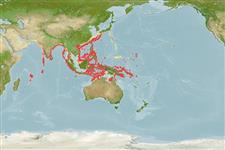>
Eupercaria/misc (Various families in series Eupercaria) >
Lutjanidae (Snappers) > Apsilinae
Etymology: Lipocheilus: Greek, lipos = fat + Greek, cheilos = lip (Ref. 45335).
Environment: milieu / climate zone / depth range / distribution range
Écologie
marin démersal; profondeur 90 - 340 m (Ref. 9821). Deep-water; 33°N - 16°S, 59°E - 167°E (Ref. 55)
Indo-West Pacific: Arabian Sea to Vanuatu, north to the Ryukyu Islands, south to northern Australia.
Taille / Poids / Âge
Maturity: Lm ? range ? - ? cm
Max length : 50.0 cm SL mâle / non sexé; (Ref. 9821); common length : 60.0 cm TL mâle / non sexé; (Ref. 5450)
Épines dorsales (Total): 10; Rayons mous dorsaux (Total): 10; Épines anales 3; Rayons mous anaux: 8. Mouth large, adults with a thick, fleshy protrusion at anterior end of upper lip. Maxilla without scales. Interorbital space flattened to convex. Dorsal and anal fins without scales. Last dorsal and anal soft rays not produced. Pectoral fins long, reaching beyond level of anus. Scale rows on back parallel to lateral line.
Adults are found over rocky bottoms of the continental shelf. Probably feed on fishes and large invertebrates.
Life cycle and mating behavior
Maturité | Reproduction | Frai | Œufs | Fécondité | Larves
Allen, G.R., 1985. FAO Species Catalogue. Vol. 6. Snappers of the world. An annotated and illustrated catalogue of lutjanid species known to date. FAO Fish. Synop. 125(6):208 p. Rome: FAO. (Ref. 55)
Statut dans la liste rouge de l'IUCN (Ref. 130435)
Menace pour l'homme
Harmless
Utilisations par l'homme
Pêcheries: commercial
Plus d'informations
Noms communsSynonymesMétabolismePrédateursÉcotoxicologieReproductionMaturitéFraiRassemblement de ponteFéconditéŒufsDéveloppement de l'œuf
RéférencesAquacultureProfil d'aquacultureSouchesGénétiqueElectrophoresesHéritabilitéPathologiesTraitementNutrientsMass conversion
Outils
Articles particuliers
Télécharger en XML
Sources Internet
Estimates based on models
Preferred temperature (Ref.
123201): 13.8 - 23.4, mean 18.3 °C (based on 189 cells).
Phylogenetic diversity index (Ref.
82804): PD
50 = 1.0000 [Uniqueness, from 0.5 = low to 2.0 = high].
Bayesian length-weight: a=0.03467 (0.01595 - 0.07536), b=2.91 (2.70 - 3.12), in cm total length, based on LWR estimates for this species & (Sub)family-body (Ref.
93245).
Niveau trophique (Ref.
69278): 3.9 ±0.60 se; based on food items.
Generation time: 5.1 ( na - na) years. Estimated as median ln(3)/K based on 2
growth studies.
Résilience (Ref.
120179): Milieu, temps minimum de doublement de population : 1,4 à 4,4 années (Preliminary K or Fecundity.).
Fishing Vulnerability (Ref.
59153): Moderate to high vulnerability (50 of 100).
